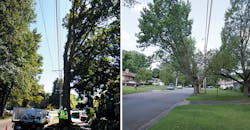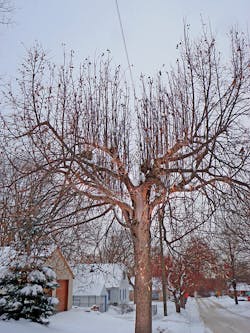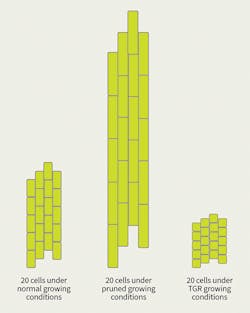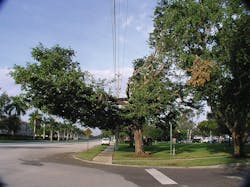Five Things to Know About Tree Growth Regulators
Tree growth regulators (TGRs) increasingly are being integrated into vegetation management programs across the U.S. and changing the way trees are cared for under power lines, around them, and along rights-of-way. For those who are not familiar with TGRs — and even for those who are — there may be a few things about them that are surprising to learn.
From reducing maintenance costs to improving crew safety to creating better customer relationships, TGRs do more than just regulate tree growth. While they are becoming more commonplace in utility vegetation management programs, there are some aspects of TGRs even professionals may not know.
1. TGRs Improve Safety
"The safest tree is the one that doesn’t have to be pruned." This statement is one of the truest ways TGRs can impact the world of vegetative management positively. It is no secret working in and around trees is a dangerous occupation. In fact, in 2016, the U.S. Bureau of Labor Statistics determined tree work is the most dangerous job in America in terms of injuries and fatalities.
Combine tree work, heavy machinery and electrical lines together, and it is easy to see why vegetation management is considered one of the most hazardous work environments today. However, TGRs can be used in a few ways to promote and increase safety.
Extending prune cycles on a given circuit is one way TGRs promote safety. If one can prune a circuit every four to six years instead of every two to three years, there are fewer opportunities for an incident to occur on the circuit. The benefit is even greater for sites that pose hazards such as vehicle traffic, pedestrians or difficult access. Every opportunity to take workers out of those situations will have a positive impact on safety.
Even pruning trees that have been treated previously with TGRs can result in safer situations as there is less biomass to remove on subsequent cycles. In fact, the reduction of biomass can be as high as 75%, meaning there is less physical material to remove from the trees, which requires less work for the climber or bucket worker. On average, there is a 53% savings in prune and chip time compared to pruning untreated vegetation. It also means there is less biomass to run through the chippers, and every minute not running a chipper should be considered an improvement in safety.
2. TGRs Are Thoroughly Researched
If all this talk about TGRs is new to someone, it may be comforting to learn they have been studied intensely for the better part of a century. Many of the technologies associated with growth regulation date back to the start of the Green Revolution. The Green Revolution period refers to the beginning of modern, intensive agriculture that came about from research funded by World War I and World War II. During this time, new technologies for affecting the growth of plants were being developed as the effects of inorganic nutrients and plant hormones were becoming better understood. This included products that would stimulate the growth of plants and stunt their growth.
Broadly defined, a growth regulator is simply any chemical used to alter the growth of a plant or a part of the plant. While one could technically argue water and nutrients are chemicals that alter the growth of plants, growth regulators more specifically work with plant hormones to achieve their result. There are growth regulators that can stimulate accelerated growth by promoting the formation of auxins, decrease fruit production by affecting the formation of cytokinins and ripen fruit by increasing ethylene.
The growth regulator paclobutrazol decreases vegetative growth by inhibiting the formation of gibberellins, the group of hormones responsible for cell elongation. Research into paclobutrazol began in the 1950s, and the effects of it are well understood. In fact, more than 2000 peer-reviewed studies have been published on the use of paclobutrazol in the past 50 years, and it is used all around the world in agriculture, horticulture and, of course, vegetation management.
When applied to a tree under or around a power line, these growth regulation treatments can reduce the length of regrowth by which the tree would naturally respond. The tree still produces the same number of cells; however, these cells do not stretch out as far. Over a three-year period, treated trees grow at a rate 40% to 70% less than the growth rate of untreated trees.
3. TGRs Reduce Costs
Extending prune cycles equals significant cost savings. It costs less to keep trees out of power lines with TGRs than with chain saws for a few reasons. Some are related to the safety benefits mentioned. Fewer site trips, reducing the time for repruning and reducing the use of heavy machinery — together, these avoided activities add up to an average of 25% to 30% savings over a traditional vegetation management budget.
There are labor savings, too, as TGR crews require less labor and equipment to function compared to pruning. Time is one of the most expensive assets in any pruning job. For example, sites such as back lots are difficult to access and require significantly more time to achieve results, simply from the added challenge of getting into position. A study evaluated 1310 back-lot trees for pruning with TGRs and pruning alone to understand the cost difference. Researchers found, after four years, only 223 of the trees required additional pruning after the first cycle. Pruning with TGRs represented a 60% cost savings for the utility over four years compared to pruning alone.
Cycle-buster trees are where the greatest financial benefits of TGRs are realized. In some parts of the U.S., cycle busters completely wreck the normal cyclic trimming plans utilities put in place, causing spikes in unplanned spending. Worse, these cycle-buster trees take crews away from routine maintenance pruning, furthering the backlog of work. TGRs make vegetation management budgets more predictable by reducing rampant growth back into the clearance zones following a pruning cycle while also saving money. An investor-owned utility looked at the cost of cycle-buster trees with and without the use of TGRs. It found the cost of maintaining 100 17-inch (432-mm) hackberry trees was 35% lower when TGRs were used, even when accounting for the cost of the TGR applications.
Of course, cycle busters are not only miles of problematic trees, but often an individual specimen that requires all-too-frequent maintenance. For example, consider the public utility with a large tree in front of a middle school. The tree would likely have been removed in another location, but, given the proximity to the school and the benefit of the shade provided to students, the utility attempted to maintain it in the least impactful manner by retaining as much of the canopy as possible. This helped with the aesthetics and social benefit of the tree but required pruning every 24 months to maintain clearance. After a TGR application, the tree is now on a 48-month pruning cycle.
4. TGRs Promote Tree Health
How does a product known to reduce cell elongation result in trees being greener as well as more drought and stress tolerant? That answer comes from research aimed at better understanding the secondary effects growth regulation has on trees. Trees produce their energy by photosynthesis, which takes place in the leaves.
Trees treated with growth regulators produce an equal amount of energy as untreated trees, but where they put the energy differs. Think of energy like funds in bank accounts, the more one allocates to one account, the less available for allocation to another. With plants, the less energy spent on vegetative growth, the more they must allocate to other resources such as defensive compounds, fibrous root growth, carbohydrate storage and reproductive structures like flowers.
Arborists often will employ growth regulation treatments on trees expected to realize root damage during an upcoming construction project as a means of pre-stress conditioning. TGRs also are used after root loss or damage to encourage the tree to form new roots. In addition, TGRs help trees to adapt better to poor soil conditions, enabling them to thrive even in times of drought. While these benefits are not at the forefront of the system forester’s mind when it comes to managing trees under power lines, they play a major role in the customer’s mind.
5. TGRs Improve Customer Relations
The paradox of utility customers is they all want electricity available every single moment, yet no one ever wants their trees pruned by the utility. While TGRs will not eliminate sensitive customers, they can be used as a tool to align the utility’s need to deliver safe, reliable electrical service with ample vegetation clearance and the customer’s desire for fewer intrusions. TGRs are an alternative appreciated by many customers. TGRs are fast and quiet to apply and, because they last for multiple seasons, they require fewer site visits than pruning alone.
Promoting tree health is another area where TGRs help align the customer’s desires with the utility’s needs. Paclobutrazol treatments are known to increase a tree’s fibrous root system, increase disease resistance and give the tree darker, greener leaves. These treatments also have been shown to increase drought tolerance. A slower-growing tree will be putting more energy into root production than shoot production, and it can be more responsive to urban tree-stress conditions. TGR treatments also trigger changes in leaf morphology, such as a thicker waxy cuticle layer and increased trichromes — the leaf hairs that help to protect the stomata.
While nothing will help a tree through times of drought better than water, growth regulators represent one of a small number of tools arborists use to help trees thrive when it is dry. Informing customers that TGR treatments aimed at keeping branches out of power lines also are creating a tree better suited to withstand hot summer temperatures and other stressful conditions is an important way to improve customer relations.
The Future of TGRs
TGRs may not be new, but new findings of how they can benefit vegetation managers are emerging all the time. In addition, the scientific understanding of TGR tools is constantly improving. Yet, there is a need for further education both within the vegetation management industry and with utility customers regarding TGRs and where they are best used. Enrolling managers and stakeholders in this education effort is an important component to every vegetation management plan.
As long as there are tree branches growing into power lines, there will be a need to keep them clear. TGRs will not solve every problem on every circuit, but they can be one of the tools in the toolbox to help utilities meet their vegetation management goals. ♦
Brandon Gallagher Watson has served in various roles at Rainbow Treecare companies over the past 13 years and is currently serving as creative director. His arboriculture career was sparked by a love of trees and an interest in ecology. With an art and design background, he obtained his tree education from the University of Minnesota’s College of Natural Resources for Urban Forestry.
About the Author
Brandon Gallagher Watson
Creative Director
Brandon Gallagher Watson has served in various roles at Rainbow Treecare companies over the past 13 years and is currently serving as creative director. His arboriculture career was sparked by a love of trees and an interest in ecology. With an art and design background, he obtained his tree education from the University of Minnesota’s College of Natural Resources for Urban Forestry.




